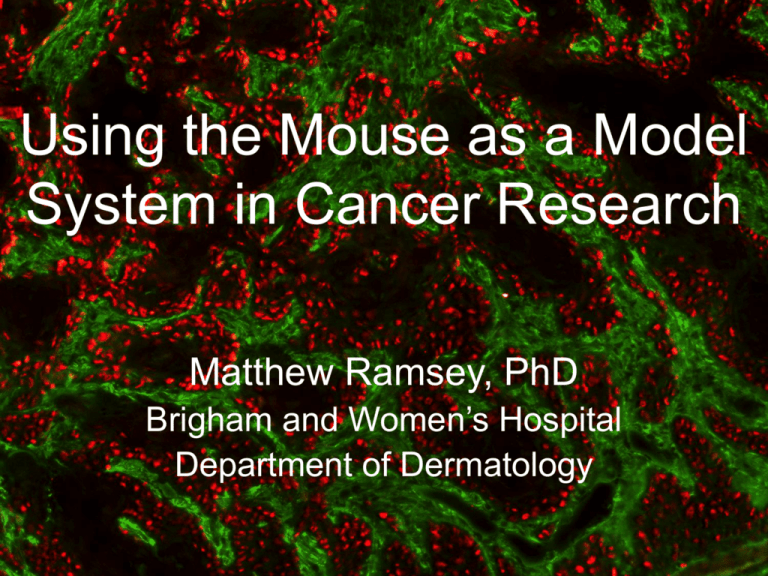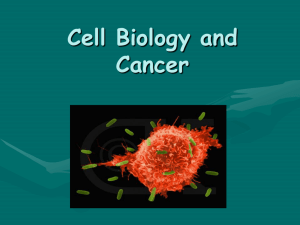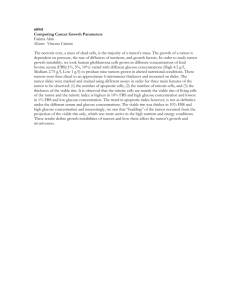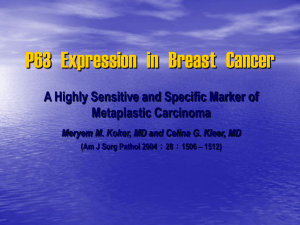Using the Mouse as a Model System in Cancer Research – Matt
advertisement

Using the Mouse as a Model System in Cancer Research Matthew Ramsey, PhD Brigham and Women’s Hospital Department of Dermatology Why study cancer in the mouse? • Protein-coding regions of the mouse and human genomes are ~85% identical • • • Tumors evolve and grow in the context of non-tumor cells Local microenvironment of tumor cells can impact tumor growth • • • Very similar physiology Reasonably short lifespan Genetic homogeneity reduces variation in system Ease of genetic engineering results in immense genetic toolkit Getting to treatments that benefit patients • Models need to be designed to reflect human tumor genetics • Intervention studies need to be performed in established tumors • Treatment schedules need to reflect realities of patient treatment • Tumors need to REGRESS after treatment! How do we make murine cancer models? The “Hallmarks of Cancer” Douglas Hanahan and Robert A. Weinberg, Hallmarks of Cancer: The Next Generation, Cell, Volume 144, Issue 5, 2011, 646 - 674 Generation of Squamous Cell Carcinoma by chemical carcinogens Normal Dysplasia DMBA DMBA TPA Papilloma SCC Genetically-defined tumor models Tumor suppressors Genes which contribute to tumorigenesis when inactivated (p53, p16INK4a) Oncogenes Genes which drive tumorigenesis by being activated (K-RasG12D) Making Transgenic Mice From: Gilbert, Scott F., Developmental Biology, Tenth Edition, Sunderland (MA): Sinauer Associates, 2013 First tumor-prone transgenic mice Key early tumor models • Richard Palmiter lab: Em-myc B-Cell lymphoma (Adams et al, Nature,1985) • Phillip Leder lab: MMTV-c-Myc, mammary adenocarcinoma (Stewart et al, Cell, 1984) • Douglas Hanahan lab: RIP-Tag Pancreatic Islet tumors (Hanahan D., Nature, 1985) Examining tumor-suppressor genes in the mouse using germline knock-outs 1 2 1b p15Ink4b 1a p16Ink4a Cdk4/6 Cyclin D Tumor Suppressor Oncogene 2 p19Arf Mdm2 p21Cip1 pRb E2F Modified from: Kim and Sharpless, Cell 2006. p53 3 Map of the murine Ink4a/Arf Locus and targeting constructs p16INK4a / p19ARF p15Ink4b Ex 1 B Ex 2 B Ex 1b R1 Acc R1 Ex 2 Ex 1a 1b Probe SacI X R1 X SacI 1a Probe Xho Xmn BssHII TK Ex 3 Not 1 kb TK PGKNeo PGKNeo R1 Exon 1b targeting construct Exon 1a targeting construct WT 4.8 kb WT 8.0 kb KO 2.2 kb KO 9.8 kb EcoR1 Digest = LoxP Site Sac I digest X Making germ-line knock-out mice From: Gilbert, Scott F., Developmental Biology, Tenth Edition, Sunderland (MA): Sinauer Associates, 2013 Tumor Incidence In Mice Lacking p19Arf and/or p16Ink4a Spontaneous Tumors Tumor Free Survival 100 Wild-type 50 p16Ink4a -/- p16Ink4a/p19Arf -/p19Arf -/0 0 20 40 60 80 100 Weeks Sharpless, NE et al, Oncogene, 2004 Studying Activated Oncogenes Cre-LoxP system for conditional modification of genomic DNA Image from: http://cre.jax.org/introduction.html Conditionally activated oncogenic alleles Adenoviral CRE Dental Floss Lox-STOP-Lox-Rosa26-LacZ Adeno-Cre Adeno-Empty Lung tumors in K-RasG12D Lkb1-/- mice show all histologies of NSCLC Sq Ad LCC Mixed SCC Inducible alleles Doxycycline-regulated alleles Tet-Off Tet-On From: Mouse Models of Cancer: A Laboratory Manual, Cold Spring Harbor Protocols, Spatial and temporal regulation of CreRecombinase using CreER alleles Tamoxifen CYTOPLASM NUCLEUS Keratin 14 promoter Cre Recombinase Estrogen Receptor K14-CreER Tumor Volume (mm3) Examining tumor maintenance using CreER alleles in GEMM mice with chemical induction Percent Tumor Free 100 80 60 40 p53+/+ p53+/p< 0.0001 20 200 175 150 125 100 75 50 25 0 Papilloma SCC 0 50 100 150 200 250 Days After Start of DMBA Treatment 0 0 50 100 150 200 Days After Start of DMBA Treatment SCC Papilloma Ramsey et al., J Clin Invest, 2013 Cre-mediated excision of p63 in vivo Keratin 14 promoter Cre Recombinase Estrogen Receptor K14-CreER 4 5 6 7 8 p63flox Cutaneous SCC + Tamoxifen 8 4 p63Brdm3 Keratin 14 p63 (p63-ablated) 5 7 6 Excision of p63 in SCC in vivo results in rapid tumor regression Apoptosis p63 intact p63 ablated 2.0 Tamoxifen % CC3 Positive 1.8 1.4 1.2 1.0 10 8 6 4 2 0 0.6 0.4 0.2 * Day 6 * Day 8 Proliferation p63 intact p63 ablated 0.8 p63L/L; WT p63+/L; WT p63L/L; K14-CreER p63+/L; K14-CreER 0.0 0 1 2 3 4 5 6 7 8 9 10 11 12 13 14 15 Days after start of treatment % Ki67 Positive Relative Tumor Volume 1.6 25 20 15 10 5 0 * Day 6 ** Day 8 Ramsey et al., J Clin Invest, 2013 CRISPER-Cas models What is CRISPER/Cas? What is CRISPER/Cas? PAM =Protospacer adjacent motif Hui Yang, Haoyi Wang & Rudolf Jaenisch, Generating genetically modified mice using CRISPR/Cas-mediated genome engineering, Nature Protocols 9, 1956–1968 (2014) Advantages of CRISPER/Cas • Highly efficient targeting of genomic locus in ES cells • Can make small insertions and deletions, generate conditional alleles, generate specific point mutations, insert reporters, or insert tags • Multiplexing of alleles: Can infect cells with multiple sgRNAs at one time • Increased speed of generating complex genotypes Hui Yang, Haoyi Wang & Rudolf Jaenisch, Generating genetically modified mice using CRISPR/Cas-mediated genome engineering, Nature Protocols 9, 1956–1968 (2014) Generating liver tumors using CRISPER/Cas W Xue et al. Nature 000, 1-5 (2014) doi:10.1038/nature13589 Limitations of Crisper/Cas9 system • Target sequence must have an adjacent PAM motif for sgRNA to correctly interact with genomic DNA • Multiple different mutations are induced which might not interfere with gene function • Works best if function of gene is known (ie, targeting of functional domains) • Frequency and nature of off-target effects are not known • Low efficiency of delivery to organs (like liver)








